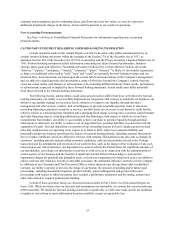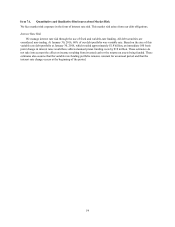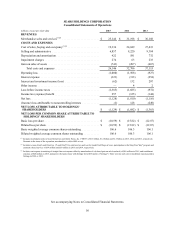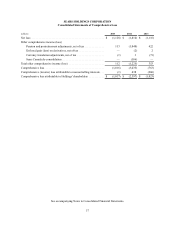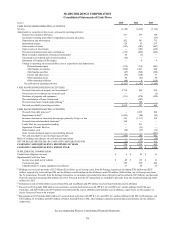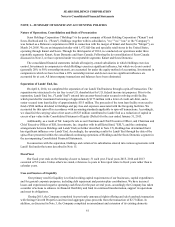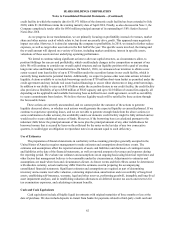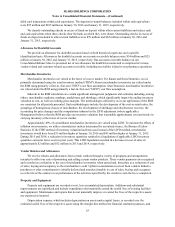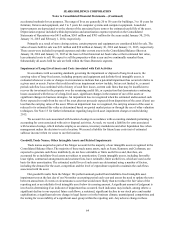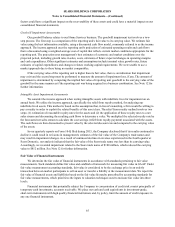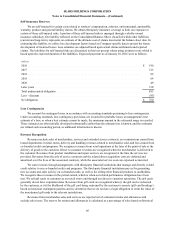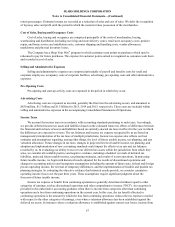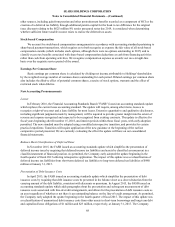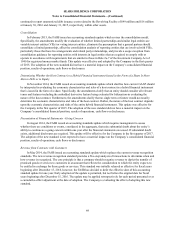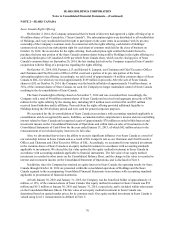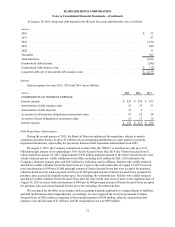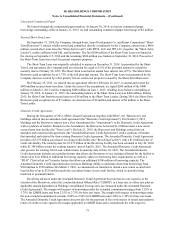Sears 2015 Annual Report Download - page 63
Download and view the complete annual report
Please find page 63 of the 2015 Sears annual report below. You can navigate through the pages in the report by either clicking on the pages listed below, or by using the keyword search tool below to find specific information within the annual report.
debit card transactions within cash equivalents. The deposits in-transit balances included within cash equivalents
were $95 million and $105 million at January€30, 2016 and January€31, 2015, respectively.
€
We classify outstanding checks in excess of funds on deposit within other current liabilities and reduce cash
and cash equivalents when these checks clear the bank on which they were drawn. Outstanding checks in excess of
funds on deposit included in other current liabilities were $59 million and $85 million at January€30, 2016 and
January€31, 2015, respectively.
Allowance for Doubtful Accounts
We provide an allowance for doubtful accounts based on both historical experience and a specific
identification basis. Allowances for doubtful accounts on accounts receivable balances were $34 million and $25
million at January€30, 2016 and January€31, 2015, respectively. Our accounts receivable balance on our
Consolidated Balance Sheet is presented net of our allowance for doubtful accounts and is comprised of various
vendor-related and customer-related accounts receivable, including receivables related to our pharmacy operations.
Merchandise Inventories
Merchandise inventories are valued at the lower of cost or market. For Kmart and Sears Domestic, cost is
primarily determined using the retail inventory method ("RIM"). Kmart merchandise inventories are valued under
the RIM using primarily a first-in, first-out ("FIFO") cost flow assumption. Sears Domestic merchandise inventories
are valued under the RIM using primarily a last-in, first-out ("LIFO") cost flow assumption.
Inherent in the RIM calculation are certain significant management judgments and estimates including, among
others, merchandise markons, markups, markdowns and shrinkage, which significantly impact the ending inventory
valuation at cost, as well as resulting gross margins. The methodologies utilized by us in our application of the RIM
are consistent for all periods presented. Such methodologies include the development of the cost-to-retail ratios, the
groupings of homogenous classes of merchandise, the development of shrinkage and obsolescence reserves, the
accounting for price changes and the computations inherent in the LIFO adjustment (where applicable).
Management believes that the RIM provides an inventory valuation that reasonably approximates cost and results in
carrying inventory at the lower of cost or market.
Approximately 49% of consolidated merchandise inventories are valued using LIFO. To estimate the effects of
inflation on inventories, we utilize external price indices determined by an outside source, the Bureau of Labor
Statistics. If the FIFO method of inventory valuation had been used instead of the LIFO method, merchandise
inventories would have been $35 million higher at January€30, 2016 and $43 million higher at January€31, 2015.
During 2015 and 2014, a reduction in inventory quantities resulted in a liquidation of applicable LIFO inventory
quantities carried at lower costs in prior years. This LIFO liquidation resulted in a decrease in cost of sales of
approximately $2 million and $32 million in 2015 and 2014, respectively.
Vendor Rebates and Allowances
We receive rebates and allowances from certain vendors through a variety of programs and arrangements
intended to offset our costs of promoting and selling certain vendor products. These vendor payments are recognized
and recorded as a reduction to the cost of merchandise inventories when earned and, thereafter, as a reduction of cost
of sales, buying and occupancy as the merchandise is sold. Upfront consideration received from vendors linked to
purchases or other commitments is initially deferred and amortized ratably to cost of sales, buying and occupancy
over the life of the contract or as performance of the activities specified by the vendor to earn the fee is completed.
Property and Equipment
Property and equipment are recorded at cost, less accumulated depreciation. Additions and substantial
improvements are capitalized and include expenditures that materially extend the useful lives of existing facilities
and equipment. Maintenance and repairs that do not materially improve or extend the lives of the respective assets
are expensed as incurred.
Depreciation expense, which includes depreciation on assets under capital leases, is recorded over the
estimated useful lives of the respective assets using the straight-line method for financial statement purposes, and
SEARS HOLDINGS CORPORATION
Notes to Consolidated Financial Statements—(Continued)
63


